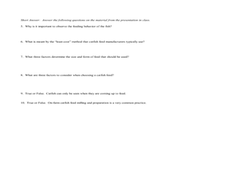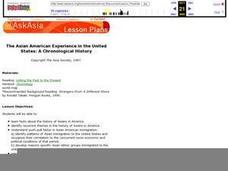Curated OER
The History of Trees-Forest Succession
In this forest succession worksheet, students read about the history of trees and forest succession. Worksheet has no other associated activities, but has a web site reference for additional activities.
Curated OER
Inspired Science
Students explore the process of invention from an inventor's conception and as a factor of history. They are shown how inventions evolve and how inventions influence the world around them Students chart the inception and affects of a...
Curated OER
Earth's History
Sixth graders investigate how fossils are formed. They analyze a photo of the Grand Canyon, and create a fossil cast and mold using plaster of paris and shells.
Curated OER
Interpreting the History, Geology, and Ecology of Monterey Bay
Students explore what they know about Monterey Bay in the special topics course and share their information with K-12 grade children at local schools by participating in the Virtual Canyon Project. Students in this service learning...
Curated OER
Aquaculture Science
Young scholars research the different careers in aquaculture. In this aquaculture instructional activity students complete activities that include a PowerPoint presentation.
Curated OER
Ancient Hunters of the Great Lakes
Young scholars describe theories on how the first humans came to America and show the evidence that supports it. In this investigative lesson students study given material and prepare written or oral reports in their groups.
Curated OER
Nutrition and Food Science
Students examine the causes and symptoms of food-borne illnesses and ways to prevent them. In this nutrition lesson students work in teams to investigate a type of food-borne illness and present a scenario about it.
Curated OER
Science of War
Tenth graders, from an environmental perspective, study the pros and cons of war. Distinctions between characteristics of biological, chemical and nuclear threats and the impact of economic development are considered.
Curated OER
History of the Battery
Students study the development of batteries. In this electrochemistry instructional activity, students compare the different types of batteries. They explore its applications especially in the medical field.
Curated OER
Microbes & History: Microbial influence on the spread of Civilization
Students explore how to extract plant fibers from the flax plant Linum usitatissimum in the process of making linen fibers. Doing so spark interest in the importance of microbial action on the spread of human culture and civilization.
Curated OER
History of Famous Women
Students discover the famous women who changed society by setting positive examples. In this equality lesson plan, students research a female person who had a positive effect on the world by fighting for her equal rights. ...
Curated OER
History of the Universe
High schoolers describe how the universe was formed. In this astronomy lesson, students listen and respond to questions in a PowerPoint lesson that includes various theories about how the universe was created.
Curated OER
History of Atomic Theory
Learners study the significance of the quantum model and how scientific theories adapt over time. In this investigative lesson students describe the contributions that scientists have helped develop the atomic theory and identify...
Curated OER
Public Lands: Hidden Histories
Students identify the economic, scientific, recreational, and spiritual values of public lands. They interpret First Nations quotes that demonstrate the unique relationship between First Nations and the land. Students identify important...
Curated OER
Science Italian Style: Eruption!
Students explore ways scientists prepare for a volcanic eruption. They observe films of earthquakes, oil spills, volcanoes and hurricanes. Students perform activities to demonstrate the relationship of viscosity to lava flow. They...
Curated OER
The Asian American Experience in the United States: A Chronological History
Eleventh graders understand push-pull factor in Asian Amencan immigration. They identify patterns of Asian immigration to the United States and recognize their correlation to the concurrent socio-economic and political conditions of that...

















